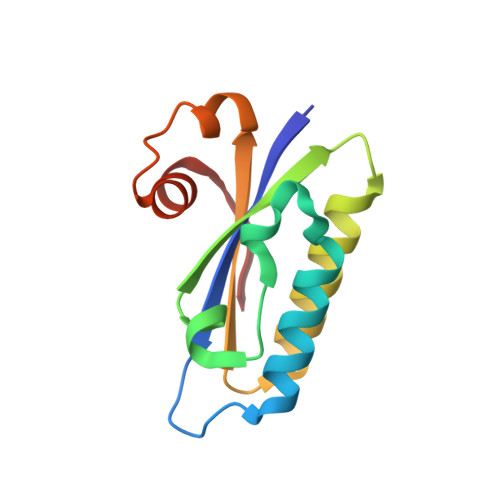Anti-CRISPR AcrIIC3 discriminates between Cas9 orthologs via targeting the variable surface of the HNH nuclease domain.
Kim, Y., Lee, S.J., Yoon, H.J., Kim, N.K., Lee, B.J., Suh, J.Y.(2019) FEBS J 286: 4661-4674
- PubMed: 31389128
- DOI: https://doi.org/10.1111/febs.15037
- Primary Citation of Related Structures:
6JHV, 6JHW - PubMed Abstract:
Clustered regularly interspaced short palindromic repeats (CRISPR)-Cas systems constitute the adaptive immunity of bacteria and archaea, degrading nucleic acids of invading phages and plasmids. In response, phages employ anti-CRISPR (Acr) proteins as a counterdefense mechanism to neutralize the host immunity. AcrIIC3 directly inhibits target DNA cleavage of type II-C Cas9 of Neisseria meningitidis. Here, we show that AcrIIC3 interacts with the HNH nuclease domain of N. meningitidis Cas9 to inhibit its nuclease activity in an allosteric manner. The crystal structure of the AcrIIC3-HNH complex reveals that AcrIIC3 binds opposite the active site on the HNH nuclease domain. AcrIIC3 employs a unique interface for HNH, allowing it to discriminate between Cas9 orthologs, which contrasts with the broad spectrum of Cas9 inhibition by AcrIIC1. Interface residues of HNH provide key electrostatic and hydrophobic interactions that determine the host specificity of AcrIIC3. Mutations that replace HNH interfaces of N. meningitidis Cas9 with those of Geobacillus stearothermophilus Cas9 or Campylobacter jejuni Cas9 significantly attenuate AcrIIC3 binding, illustrating that the divergent interaction surface confers the host specificity of AcrIIC3. Our study demonstrates that the variable sequences of binding interface can define the target specificity of Acr proteins, suggesting potential applications in Cas9 control for gene editing.
Organizational Affiliation:
Department of Agricultural Biotechnology and Research Institute of Agriculture and Life Sciences, Seoul National University, Korea.















